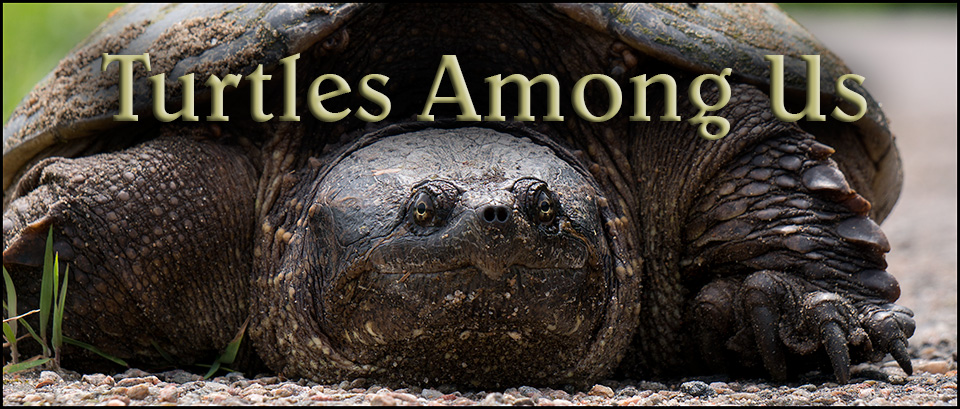TURTLES AMONG US
Article and photography by Tony & Kathy deGroot
Turtles are prehistoric and have been around since before the dinosaurs. Over hundreds of millions of years, they have evolved into a reptile unlike anything else in the world. With their hard shell and aquatic lifestyle, it has given them the ability to outlast many other animal species. Some can live to very high ages surpassing the average age of a human.
Unfortunately, our turtles are in big trouble. Turtles in Ontario are declining more than any other order. Out of the eight native species in Ontario, all but one is on the Species at Risk List. Ironically, the same government department that puts the Snapping Turtle on the species at risk list also continues to allow hunting and harvesting.
The signature of the turtle is their protective shell. However, although this armour may be tough enough for most natural challenges, they fail miserably when it comes to vehicle tires. Turtle road mortality is very high as they have to travel to suitable nesting, foraging and hibernation sites. With their slow pace, they can’t simply hop out of the way or look before crossing. It’s up to us to slow down and drive with care certain times of year and in areas known to be a high risk turtle crossing. And it’s not that hard to do. It’s not like the jump in front of the car without notice. Although, I am sure there are rare occasions where it is not avoidable, more times than not, by slowing down, braking and being watchful, there could be a significant decrease in turtle road fatalities.
If you do see a turtle crossing the road and it is safe to do so, stop, put your emergency four-way lights on and assist the turtle across the same way it is travelling. Even by protecting it from traffic is a great help if you don’t want to handle the turtles. Be careful with Snapping Turtles as their automatic (and only) defence is to snap at anything they see as a threat. There are safe ways to assist a Snapping Turtle and some examples can be seen at these videos. <-- (click here)
Another problem facing our turtles is predation. This unfortunately has much to do with humans as well as the most common predators are animals that are thriving because of us. Raccoons, skunks and foxes are the number 1, 2 and 3 villains of turtle eggs and these species appear to be increasing in population. They are all opportunist that can not only live close to human populations, but they benefit and flourish. The chance of a turtle becoming an adult is extremely low.
Of course, the biggest threat to turtles is the loss of habitat. And, here again, it’s us humans who are responsible. Wetlands are drained for development, roads are built between wetlands (sometimes causeways are built through the wetlands), shorelines are developed for homes, cottages, marinas, lodges, etc. This all has a significant impact on our turtle population. We need to have protected areas for turtles to live, hibernate and to nest. Areas like Ostrander Point should have special protection as an important area for the endangered Blandings Turtle. Those wind turbines should be placed where they don’t have an impact on wildlife and important natural treasures.
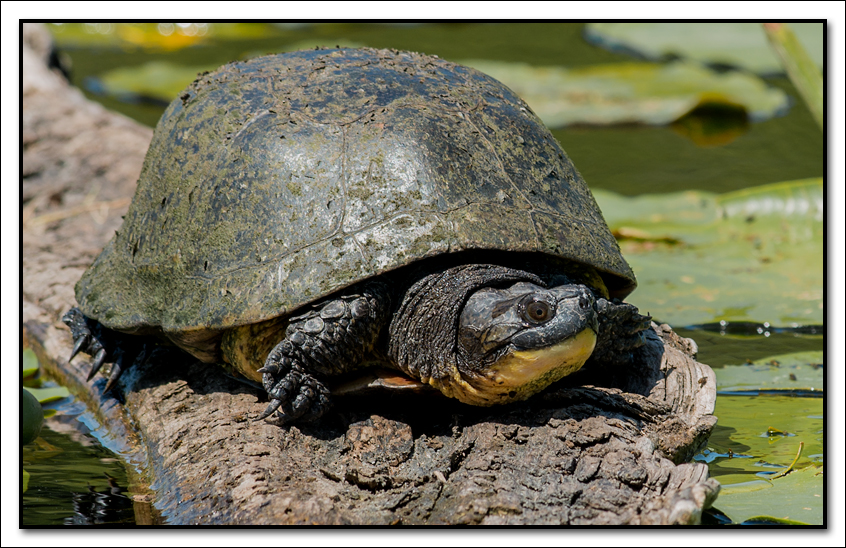 Blandings Turtle with its yellow chin and helmet shell
Blandings Turtle with its yellow chin and helmet shellLet’s meet our local turtles
Blandings Turtle (Emydoides blandingii) – Status: Threatened
The Blandings Turtle can be easily identified by its yellow chin and helmet –like dome of a shell. They have yellow spots on the shell that fades with age. The mouth curves slightly in the corners giving the Blandings a happy look. The eyes protrude above the head adding to the cuteness factor of this rarely seen turtle. These guys can be found in still waters with plenty of aquatic vegetation and are spread out sporadically throughout the southern and central regions of Ontario. They are known as travellers because they tend to move around to different locations within their home range. This, of course, makes them vulnerable to traffic injuries and fatalities.
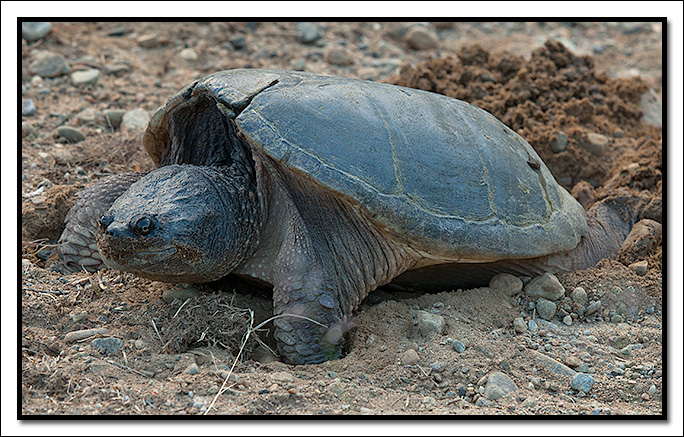 Snapping Turtles are occasionally seen laying eggs in early to mid-June
Snapping Turtles are occasionally seen laying eggs in early to mid-June
Snapping Turtle (Chelydra serpentine) – Status: Special Concern
The Snapping Turtle is Ontario’s largest turtle by far. In Algonquin Park, we have seen some that have grown to monstrous sizes, often with their shells green with algae. They have powerful pointed beaks and extremely long necks. The speed they can accomplish with stretching their necks is quite amazing as they snap towards their prey.
Snapping Turtles are the only turtle in our region that can’t fully withdraw in its shell. Because of this, their only defence on land is to snap with their powerful jaws or scratch with their long claws. Because of this, there are often mistakenly looked at as aggressive. They usually only respond when they are grabbed or poked.
They are not aggressive at all while in the water. When I was a kid, I used to go out fishing very late at night using a Jitter-bug. It would be pitch dark and all I could hear was the bubbling of the surface lure; until a bass strikes. I would be standing knee deep in the river in my bare feet. One evening, I felt something and turned on my flashlight on. There swimming around my toes was a massive Snapping Turtle. As my heart pounded, he foraged all around me. I was not about to move; not even wiggle my toes. He slowly moved on. After that, I felt honoured to be in its presence.
Snappers rarely leave the water other than to lay their eggs in early to mid-June. The young hatch in September. I have seen newly hatched snapping turtles in late September heading to the lake in Algonquin and had to crawl over the thin layer of ice on the shoreline to reach the water. They must have to hibernate very shortly after birth.
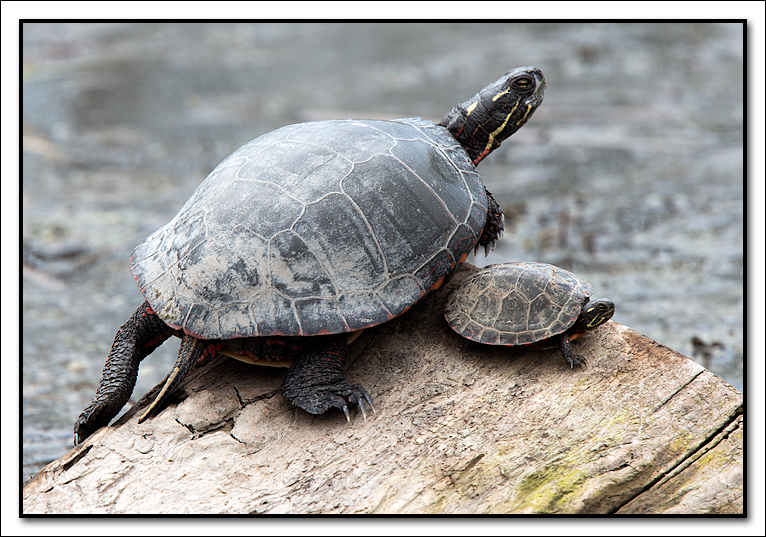 Painted Turtles seem to enjoy each other's company as they often bask in groups
Painted Turtles seem to enjoy each other's company as they often bask in groups
Painted Turtle (Chrysemys picta) Status: Not at Risk
The Painted Turtle has two subspecies in Ontario, the Western and the Midland and is the only turtle native to Ontario that is not on the Species at Risk List. Like all of our turtles, the painted turtle is very easy to identify with its brightly coloured neck, legs and underskirt of vibrant red, yellow and orange streaks and lines.
Painteds are common and can be seen in groups of all sizes, basking together on logs, rocks or just about anything they can crawl up on (including each other). They are the most widespread of our regional turtles and can be found in just about any type of aquatic habitat. The reason why we may see juvenile Painted Turtles earlier in the year than most other turtles is because they usually overwinter in the nests and emerge in the following spring.
Spiny Softshell Turtle (Apalone spinifera) – Status: Threatened
I have only seen one Spiny Softshell Turtle in my life, and that was ages ago. Their range is limited to the most southern area of Ontario with an isolated spot on the Ottawa River. They prefer sandy or muddy rivers and lakes. Spiny Softshells are unique with their pointed snouts and flat soft leather-like shells. Their shells are generally brownish green with black ringed circles and dots spread out handsomely on their backs.
Musk Turtle, a.k.a. Stinkpot (Sternotherus odoratus) – Status: Threatened
As far as I know, I have never seen a Musk Turtle. This is Ontario’s smallest turtle and is famous for releasing a foul smelling liquid when they feel threatened. This aquatic turtle has a small brownish to black shell that is often carpeted with green algae.
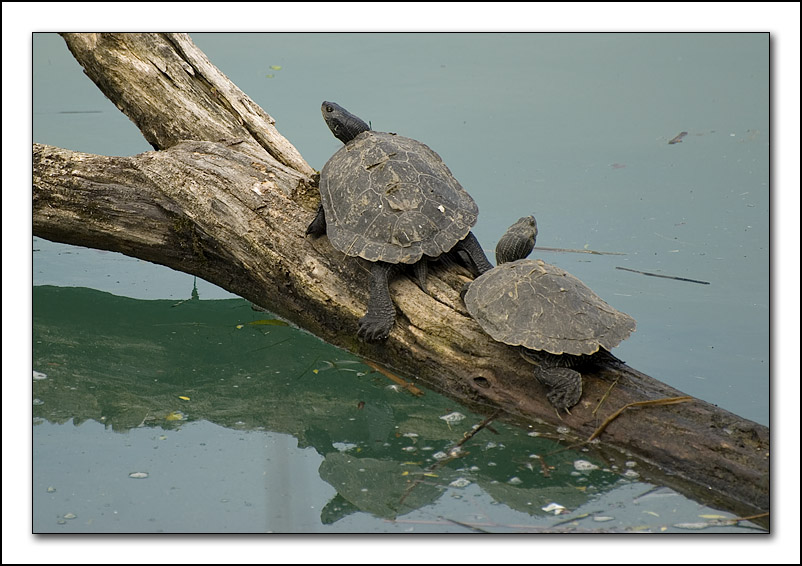 Northern Map Turtles basking on a fallen tree trunk
Northern Map Turtles basking on a fallen tree trunk
Northern Map Turtle (Graptemys geographica) – Status: Special Concern
In some of the tributaries of the fresher water of Lake Ontario, Lake Erie and Lake Huron are where I have seen the Northern Map Turtle. They can be occasionally seen in small groups of 2 or 3 basking on logs and emerging rocks. This handsome turtle can be easily identified by its long thin green necks with distinctive yellow lines. Their legs, tails and skirt are also dark green with yellow lines. This species can grow quite large, especially the adult females. Not quite as large as our big Snappers, but they do outsize our other regional species.
Northern Map Turtles also hatch late, around September and are in a hurry to feed and store reserves for winter hibernation.
Spotted Turtle (Clemmys guttata) – Status: Endangered
The cuteness of this little turtle could be the reason for its demise as they have been victims of the illegal pet trade. I have only seen these guys in captivity (park visitor centres) and in pictures and I can’t deny that they are adorable. They are unmistakable as they have a dark bluish grey to black shells with bright yellow and orange spots. Their legs and chin are also adorned with orange spots.
Wood Turtle (Glyptemys insculpta) – Status: Endangered
The Wood Turtle is the other turtle that I don’t remember ever seeing even though they are the most terrestrial turtle in our region. Extremely rare, they are only now found in very isolated areas of our province and tend to hang out on both land and in the water. Their sculptured shell looks like a mosaic of tiled sea shells. They have scaled legs and a blunt nosed head giving it a tortoise like appearance.
Young Wood Turtles tend to stay close to and in the water. As they mature, they become braver and wander on land. In fact, the adults feed mostly on land. They will mostly dine on berries and leaves, but will take insects and worms as well.
Turtle watching
Turtle watching can be very rewarding. By studying them, you will soon learn to recognize your native species. In Ontario, we only have a possibility of eight native different species, so it is a fairly easy task.
It is a real treat when we see a giant snapper or a rare Blandings. During the nesting seasons, turtles must leave the safety of the water and find suitable nesting locations. They are attracted to loose soil such as gravel and sand shores, beaches, gravel bars and the like. If you are lucky to see a nesting turtle, please take care not to disturb her. This is a very trying time for her.
Using binoculars is a great way to view turtles as they are often skittish and quickly retreat into the water and disappear from site when approached. Cameras with telephoto lenses are the best way to photograph them.
Another great way to view turtles is by canoe or kayak as these motor-less vessels are quiet and easy to maneuver in shallow bays and shorelines.
Turtles in Our Future
Although it is a bleak outlook for turtles in Ontario, there are some people who are working hard to help them. The Kawartha Turtle Trauma Centre (KTTC) is a hospital for Ontario’s native turtle species. Turtle injuries are second only to habitat loss as the major reason for the population decline. As their website points out, less than 1% of turtle eggs and hatchlings will survive to adulthood and it takes 8 to 25 years for to reach maturity. That means it can take 200 eggs and up to 25 years to replace one nesting female killed on the roadside. That’s why the KTTC is so important; every turtle saved is beneficial to the population. If you find an injured turtle, please contact the KTTC through their website. <--(Click Here).
Other turtle rescue facilities include Sandy Pine Wildlife Centre in Napanee and TurtleHaven in Kitchener,
How can you help?
- Give a turtle a brake. Slowdown on roads that are known or obvious turtle crossing areas. Especially in parks and areas with turtle crossing signs.
- If you see a turtle crossing the road and it is safe to do so, stop and assist. Make sure you help the turtle go in the same direction as it is heading.
- If you find an injured turtle (in Ontario), call the KTTC. There are also facilities in Toronto, Kitchener and Ottawa. If you live in a different location, province or country, research for a turtle trauma or wildlife rehabilitation facility in your area.
- If you have property near turtle nesting areas, try to make it turtle friendly. You can even get turtle I.C.U.‘s and cover the nest for protection (a wood frame with hardware screen) Link <--(Click Here). If you live in the Belleville area, you can buy a Turtle ICU through the Quinte Field Naturalists, or contact Denice Wilkins at denicejohn@live.ca (613-478-5070)
- Newly hatched turtles are very vulnerable on land. If you come across one that is clearly far from the water, help it to the nearest body of water for its protection.
- If you are in a provincial or national park and you see a turtle laying eggs, report it to the park staff. Many parks have a program to help protect the nest.
- Help protect wetlands and wilderness areas by supporting local, provincial (state) or national nature organizations that are fighting for this cause.
- Do not pollute or litter. Plastic bags, bottles rings, fishing line are harmful to all life. This might sound obvious to most people, but it never ceases to amaze me that there are people who continue to litter our rivers, lakes and wetlands.
- Spread the word and show by example.
Turtles need our help. Things are going to have to change as the rapid decline in turtle populations has reached an alarming rate. They are an important part of our ecology and the environment. Their survival may be in our hands. And the World will be a much better place with turtles among us.
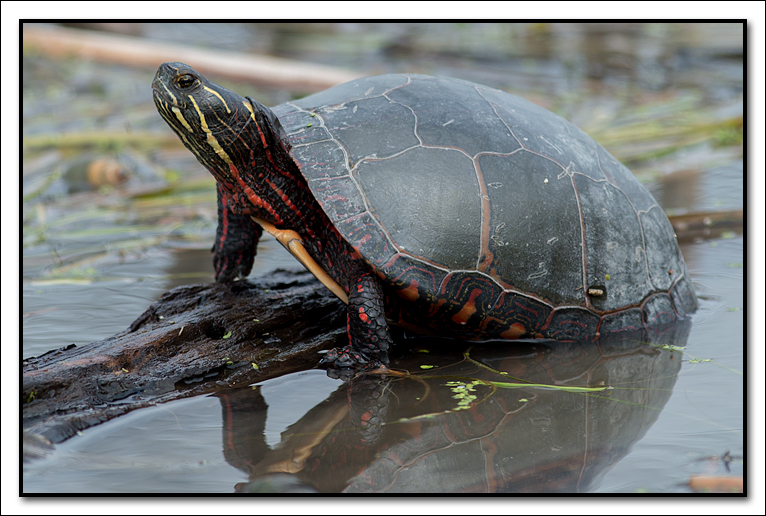 Midland Painted Turtle with its distinctive bright coloured neck and face.
Midland Painted Turtle with its distinctive bright coloured neck and face.
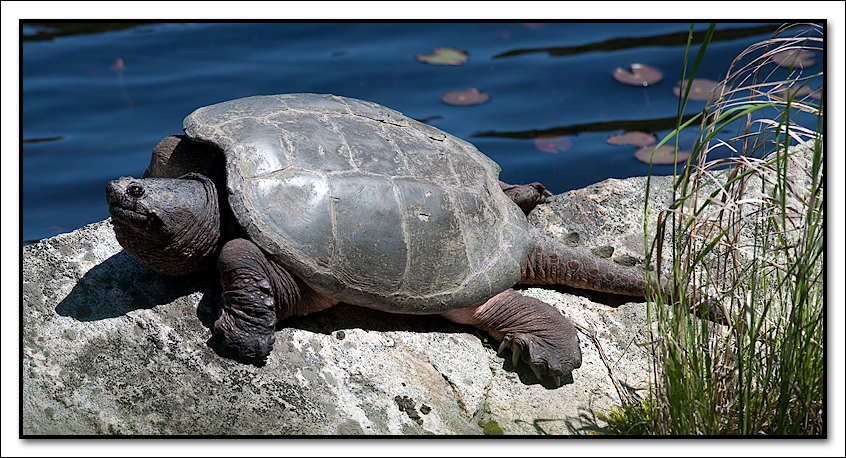 This is the largest Snapping Turtle we have ever seen.
This is the largest Snapping Turtle we have ever seen.
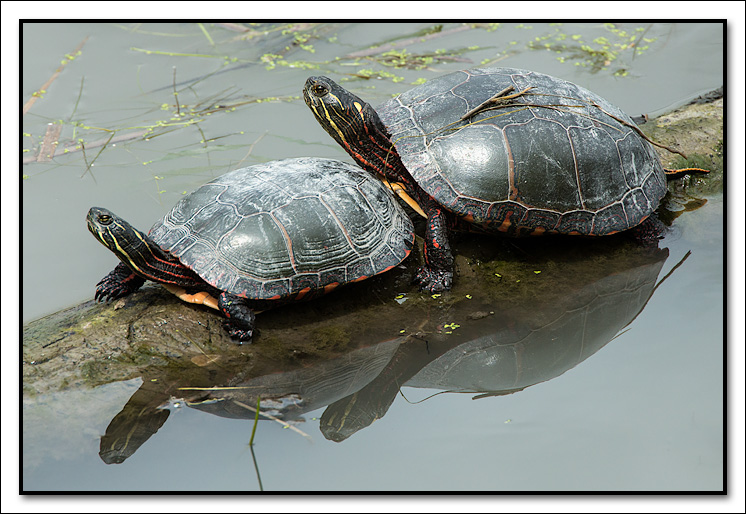 Midland Painted Turtles getting some rays
Midland Painted Turtles getting some rays
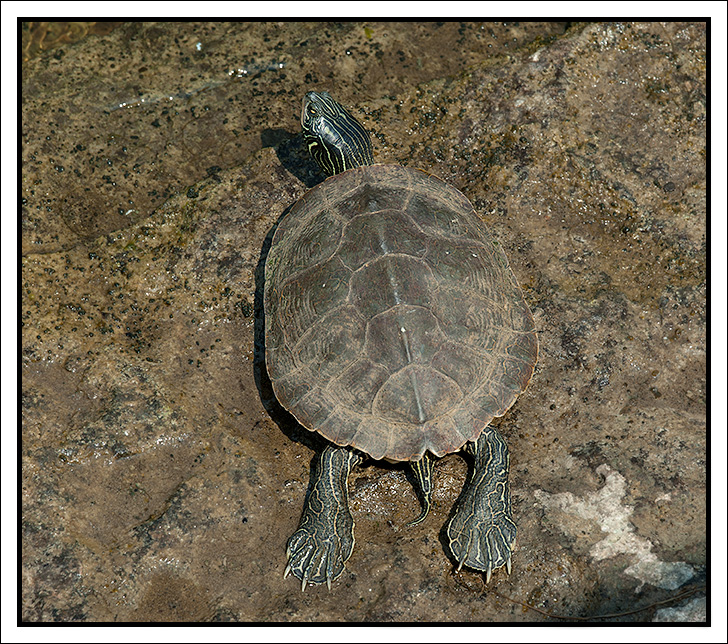 Northern Map Turtle Stretching its legs in the warm sun
Northern Map Turtle Stretching its legs in the warm sun
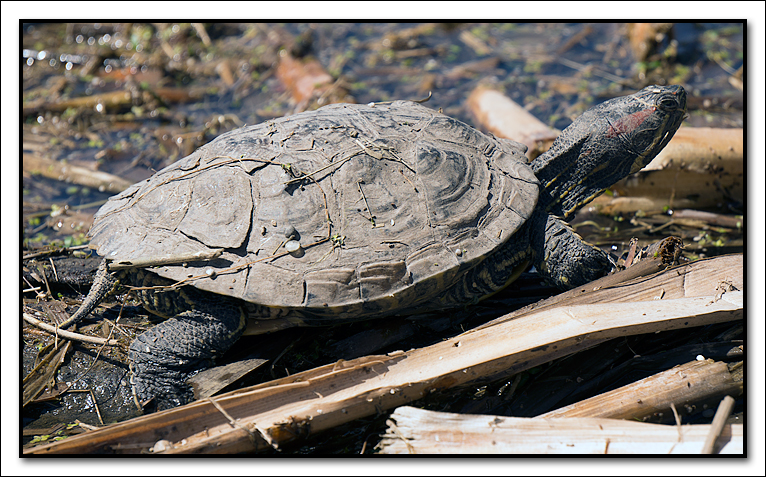 Non-native Red-eared Slider, once popular domestic pets likely released in the wild.
Non-native Red-eared Slider, once popular domestic pets likely released in the wild.
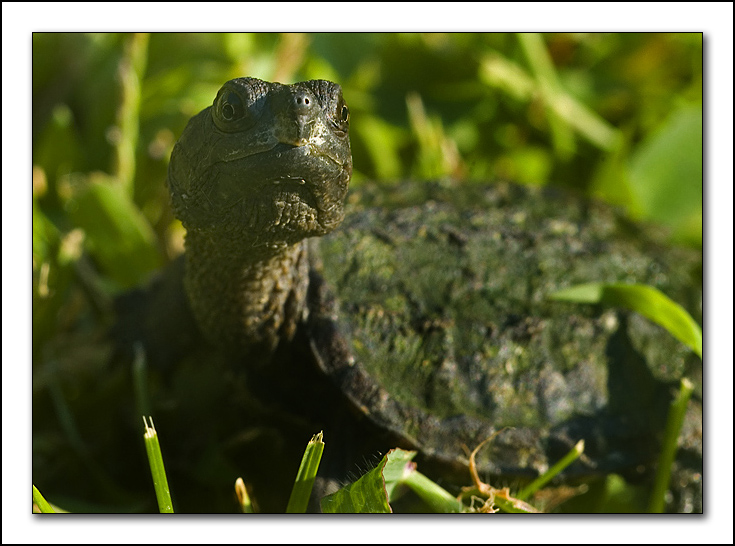
A newly hatched Snapping Turtle trying to find it's way to the water.
This guy was no bigger that a Looney.
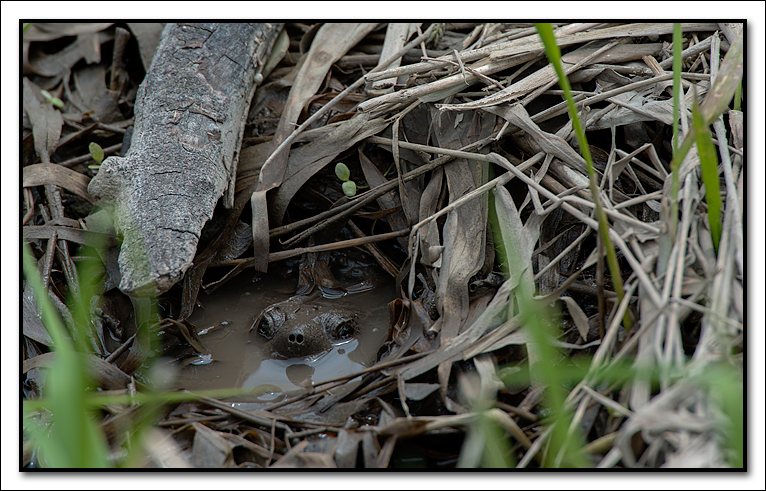
Snapping Turtle emerging from hibernation
